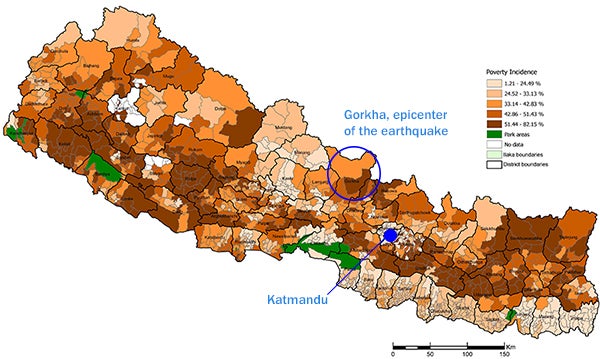
While Kathmandu is steadily fighting to get back to some sense of normalcy, the situation is very different outside the capital where all districts around Kathmandu and between Kathmandu and the tourist town of Pokhara have been very severely affected. Relief supplies - food, water, shelter and medical aid, are slowly starting to move into these areas. Let no one be mistaken, the Nepal earthquake while having impacted parts of Kathmandu quite severely is also a rural disaster of huge proportions.
The World Bank South Asia Disaster Risk Management team and the Global Facility for Disaster Reduction and Recovery (GFDRR) arrived in Kathmandu on Thursday to start planning for the post-disaster damage and needs assessment, discuss with the government a planning process for transitioning into early and mid-term recovery and help support the Nepal World Bank office coordinate with other development partners.
We visited the older neighborhoods of Bhaktapur, Basantpur and Patan in the Kathmandu Valley. A majority of the collapsed houses in these areas were old brick and mud structures that had become weak with age. These were densely built neighborhoods with narrow streets and removing debris from the area is extremely challenging. We also visited an area called Gongabu, a relatively new developed suburb with tall framed-structure buildings. We found a lot of collapsed buildings and many 5-6 storey buildings completely tilted which will have to be demolished. These type of suburbs are going to pose a big challenge in Kathmandu.
From Gorkha, epicenter of the earthquake
Over the past few evenings we have been meeting journalists returning from the field. A journalist who had returned from Gorkha, the epicenter of the earthquake, described an area that had been very severely impacted. The roads were not passable and he had to walk over 5 kilometers to access villages. Every cluster of hamlets he visited, he found almost all the houses to have collapsed. Families had lost all their stock of grain, which is usually stored inside the house, and were trying to dig through the rubble to salvage whatever they could. This story repeats in most other rural districts that have seen major devastation. Early estimates seem to indicate that more than 300,000 houses completely collapsed. Some of these districts like Gorkha, Rasuwa, Sindhuli, Ramechhap are amongst the poorest districts in Nepal with poverty incidence as high as 51-80% in some areas. The poorest have been the hardest hit. Recovery in these areas is going to be that much more difficult and yet there lies a huge opportunity to overcome poverty through smart and targeted recovery actions.
A race against time and nature in Nepal
In a month, the monsoon season will start in Nepal. Once the rains arrive, it is going to be practically impossible to get any kind of heavy vehicle carrying building materials into these mountain regions. Winter will then follow in 5 months and a lot of these areas experience snowfall and very low temperatures. This means we need to start finding workable solutions to address immediate shelter needs. This is a huge challenge.
For Nepal, the key is to start planning early recovery while the relief phase is ongoing. It is only nine days since the disaster hit but for the hundreds of thousands of families in rural Nepal, time is not on their side.


Join the Conversation